 Iodine Deficiency: Risk Factors, Symptoms, and Solutions
Iodine Deficiency: Risk Factors, Symptoms, and Solutions
Did you know that iodine deficiency is a serious global health problem? It is the most prevalent and easily preventable cause of brain damage and cognitive development impairment in children. It can also contribute to thyroid imbalance, increase your risk of goiter, and cause other health issues. Iodine deficiency is something that you need to be aware of and consciously work on preventing.
In this article, you will learn about iodine deficiency. I will discuss what iodine deficiency is and why it is a global health problem. You will learn about the symptoms of iodine deficiency. I will discuss the importance of iodine and the top causes of iodine deficiency.
You will learn how much iodine you need per day. You will understand what testing methods are out there for iodine deficiency. I will talk about the best food sources of iodine and offer some iodine-rich recipes. You will learn about iodine supplementation and about the benefits of nebulizing iodine for sinus and respiratory health.

Iodine Deficiency Is a Global Health Problem
Iodine is a mineral that your body needs to make thyroid hormones. Yet, iodine deficiency is a serious health concern in certain parts of Europe, Russia, Asia, Australia, and Africa, however, it is a problem in the United States and other parts of the Americas as well (1). About 1.9 billion people around the world are at risk of iodine deficiency. Numbers are incredibly high among unborn babies and children. This is particularly concerning since iodine deficiency is one of the top causes of preventable brain damage in children.
Brain damage in children, however, is not the only health issue that people may face due to iodine deficiency. According to the World Health Organization (WHO), about 1 billion people develop some sort of health problem due to a lack of iodine in their diet (2). Thyroid issues are the most common health concern because of low iodine levels.
Understanding that low iodine levels are a serious health issue, iodized salts became a popular tool in the 1990s (3). According to research done by the WHO, by 2011, about 70 percent of households globally had access to iodized salt (4).
Yet, according to a 2017 study published in the Current Health Science Journal, iodine deficiency is still a global problem (5). According to the American Thyroid Association, about 30 percent of the world’s population is still struggling with iodine deficiency and related health issues (6). This is true for the United States as well.
According to the Centers for Disease Control and Prevention, the iodine intake of Americans has decreased since the 1980s and about 12 percent of people in the United States have low iodine levels in their urine (7). While back in the 1970s and 80s, people worried about people taking too much iodine, this is certainly not the case today. Lower iodine levels can be traced back to dietary habits and can contribute to serious health issues, including ever-increasing thyroid diseases.

Iodine Deficiency Symptoms
Symptoms of iodine deficiency may include (8, 6):
- Goiters
- Hypothyroidism
- Headaches
- Dry skin
- Depression
- Lethargy
- Fatigue
- Memory problems
- Brain fog
- Difficulty losing weight
- Sensitivity to cold
- Cold hands and feet
- Recurrent infections
- Menstrual problems
- Miscarriage, stillbirth, and other pregnancy-related issues
- Muscle weakness
- Joint stiffness
- Constipation
- Hyperlipidemia
- Thinning hair
- Impaired kidney function

Importance of Iodine
Iodine is important for your health for a variety of reasons, including thyroid health, immune health, brain health, and more. Let’s talk about iodine and your body.
Thyroid Health
Iodine is an essential mineral that necessary for the production of thyroid hormones. Since your body is unable to make iodine by itself, you have to meet your iodine needs through your diet. Iodine deficiency can seriously impact your thyroid health. It is the primary cause of goiters around the world.
According to a 2017 meta-analysis published in PLoS One, lower urinary iodine concentration levels are linked to a higher risk of goiter, and iodine deficiency may increase the risk of goiter (9). Increased iodine intake can decrease goiter. However, untreated and long-term goiter can cause permanent damage.
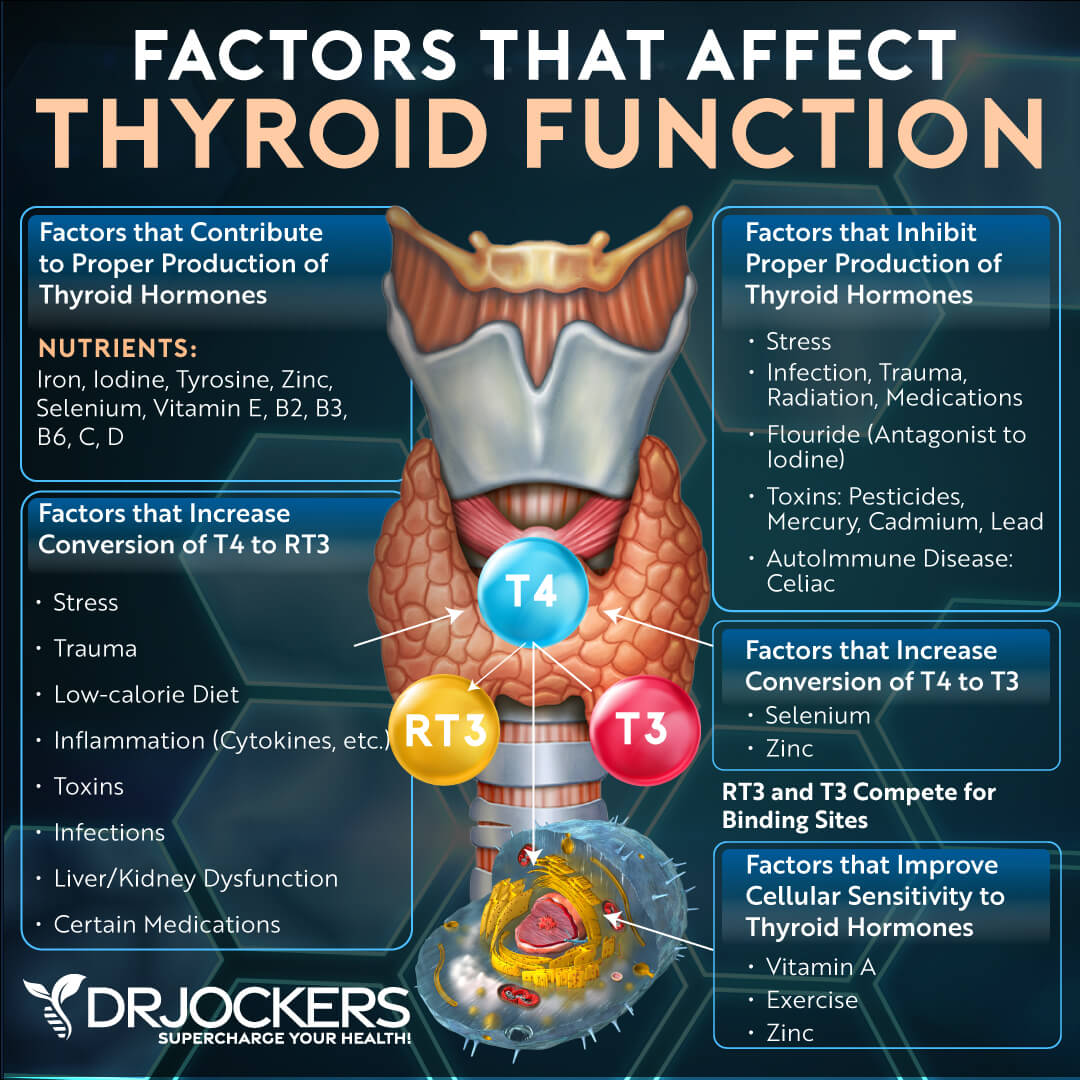
Energy & Metabolism
Iodine deficiency can also affect your metabolism and energy levels. According to a 2008 review published in Thyroid, your thyroid hormones play a major role in your basal metabolic rate and energy expenditure (10).
Because your thyroid hormones are also in charge of the speed of your metabolism, they can affect how your body converts food into energy. It’s not surprising that thyroid problems can cause unexpected weight gain or weight loss as well. Furthermore, according to a 2010 study published in Hippokratia, low thyroid hormone levels linked to iodine deficiency also result in low energy, weakness, and fatigue in most people (11).

Immune Health
Iodine can do more for your body that ensures optimal thyroid function. It plays an important role in your immune health as well. It helps to increase antioxidant activity in your body and reduce free radicals.
A 2017 study published in Frontiers in Immunology, has found that iodine has immunomodulatory effects on your peripheral blood immune cells (12). Optimal iodine levels can improve the immune system, help to clear infections, and support cellular reproduction.
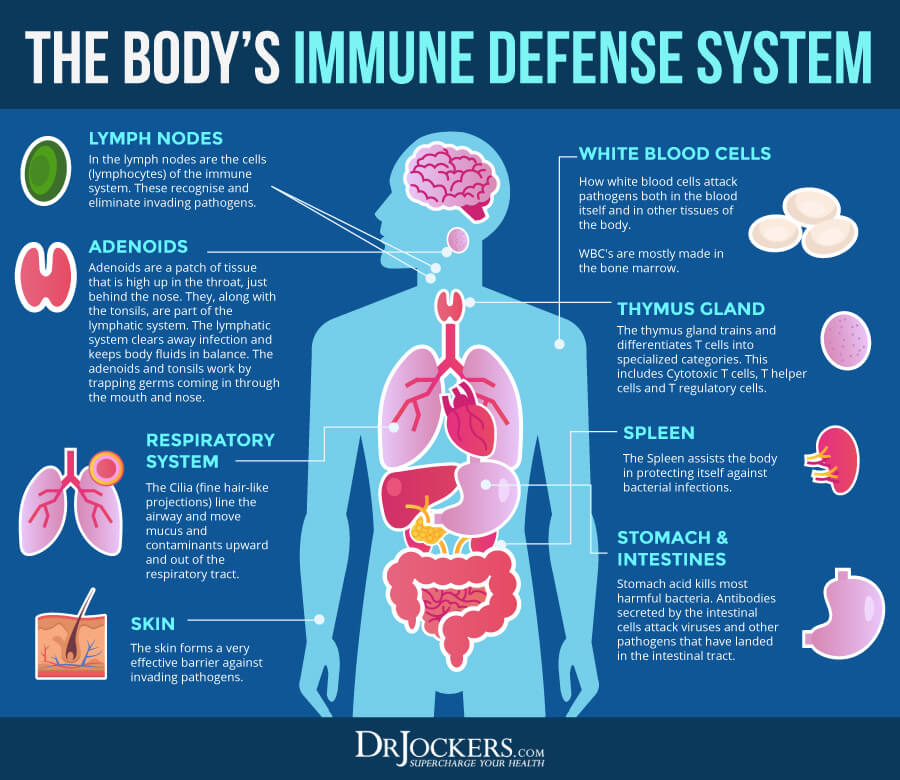
Detoxification
Iodine is also important for detoxification. Iodine can help your body to detoxify heavy metals and various biological toxins, as well as microbes. A 2013 study published in Thyroid suggests that iodine offers extrathyroidal actions, including antioxidant and apoptotic benefits (13).
It offers antibacterial properties, including against H. pylori infections, to detoxify your body from pathogens and return to homeostasis.

Skin Health
Iodine deficiencies and related thyroid issues often result in dry, flaky, inflamed, irritated, and rough skin. It can also affect your hair and dental health. Iodine deficiency can, for example, also result in hair loss along with unhealthy skin.
A 2010 study published in the Journal of Tropical Pediatrics has found that iodine and other trace elements have been connected to healthy hair and skin (14). According to a 2011 study published in Dermato Endocrinology, iodine can help the skin to regenerate and helps to reduce dry and flaky skin (15).

Brain Health
Iodine deficiency can seriously impact your brain health. A 1998 study published in the Archived of Internal Medicine has found that hypothyroidism which is associated with low iodine levels can lead to neurocognitive issues, including impaired memory function (16).
A 1998 review published in The Psychiatric Clinics of North America and a 2001 review published in the Journal of Biological Psychiatry has both found that thyroid issues can also affect the neural tissue and mood modulation and result in mood disorders (17, 18). A 2000 review published in The Proceedings of Nutritional Society has also found that iodine deficiencies and related problems with thyroid hormones can reduce brain development (19).

Breast Health
Iodine is particularly important for the breast health of women. According to a 2016 article published in Oncology Times, molecular iodine can reduce breast cell sensitivity and improve breast tissue (19).
While a 2017 study published in the Journal of Cancer has linked dietary iodine deficiency to the increased incidence of breast cancer in younger women in the United States (20).

Prostate Health
Iodine is also critical for prostate health in men. Just like the thyroid and the breast tissue, the prostate also needs iodine. A 2007 study published in Nutrition and Cancer has found that low urinary iodine and thyroid disease can increase the risk of prostate cancer (21).
A 2013 study published in Molecular Medicine has found that iodine supplementation may help to reduce tumor growth in prostate cancer (22).

Risk Factors for Iodine Deficiency
There are a variety of factors that may increase your risk of iodine deficiency, including not eating enough iodine, pregnancy, selenium deficiency, drinking tap water, environmental toxicity, and eating goitrogenic foods. Let’s look at these risk factors for iodine deficiency.
Low Iodine Intake
Meeting your iodine needs for food may not always be easy. Mountainous regions with frequent floods, such as the Himalayas, Alps, and the Andes, for example, will likely have iodine-deficient soil. This means that the livestock and population there may also become deficient. Food grown in the soils will all be low in iodine.
This is why iodine supplementation was introduced. As a 2012 paper published in Nutrients explains, iodine supplementation has improved pregnancy and cognitive outcomes in the 1970s and 1980s (23). Other than iodine supplementation, consuming sea vegetables and seafood has become the best way to fight dietary deficiencies. Later in this article, I will go over some of the best food sources of iodine and recommend some recipes.

Pregnancy
Pregnant women have a higher need for iodine than others and iodine-deficiencies during pregnancy can lead to pregnancy issues, poor brain development, impaired brain function in infants, and stunted mental and physical growth in babies.
No wonder that supplementation with iodine is common during pregnancy and breastfeeding. According to RDA recommendations, during pregnancy, women should get around 220 mcg of iodine and while breastfeeding, they should aim for 290 mcg (24). For more info on a healthy pregnancy diet to follow, read this article.

Selenium Deficiency
Selenium deficiency is often coupled with iodine deficiency and thyroid problems. It can contribute to inadequate thyroid hormone levels and the development of goiters.
According to a 2009 study published in Endocrine, Metabolic, and Immune Disorder Drug Targets, deficiencies in iodine and selenium can increase the risk of thyroid function, while supplementation can help (25).
If you have good digestion, meeting your daily selenium levels is simple. Simply eating 3-4 Brazil nuts or 5 oz. of salmon or sardines a day will supply you with all the selenium you need. Unfortunately, many people have compromised digestive health and are unable to optimally absorb selenium in their diet. In these cases, selenium supplementation can be extremely helpful and selenium works together with iodine to optimize thyroid hormone production.

Drinking Tap Water
Drinking tap water can contribute to iodine deficiency. Why? Tap water contains fluoride and chlorine which can both interfere with iodine absorption. A 2006 study published in Semantic Scholar, examined the IQ of children living in villages with high-fluoride and low-iodine or only low-iodine levels (26).
They found that children who lived in high-fluoride areas had lower IQ levels than those in areas with only low iodine. If you needed another reason to switch to purified water from tap water, adequate iodine levels are one.

Environmental Toxin Exposure
Environmental toxins exposure to tobacco and other toxins can also increase the risk of iodine deficiencies. A 1994 review published in Thyroid has found that smoking tobacco can contribute to thyroid dysfunction (27).
Tobacco contains thiocyanate, a compound that can inhibit the transport mechanism of iodine, and as a result, cause low iodine levels and related poor thyroid function. Other toxins that may also contribute to iodine deficiencies and thyroid dysfunction include nicotine, benzopyrenes, and hydroxylysine metabolites.
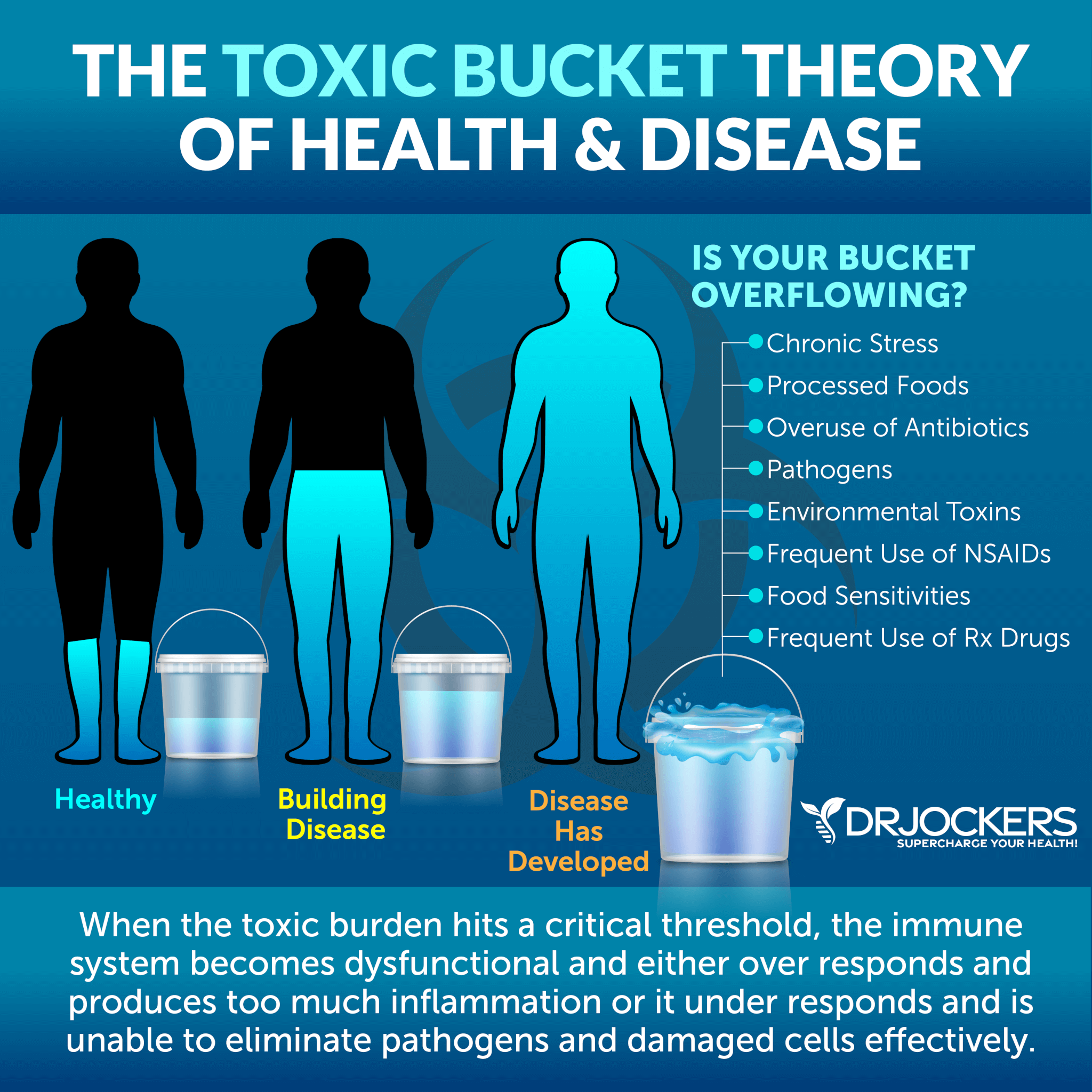
Goitrogenic Foods
Goitrogenic foods include Brussels sprouts, kale, cauliflower, broccoli, cabbage, kohlrabi, rutabaga, and turnips. Although eating goitrogenic foods is not the main cause it could further aggravate a pre-existing iodine deficiency. According to a 1995 study published in the Indian Journal of Medical Research, goitrogen foods can inhibit thyroid hormone synthesis and impact thyroid function (28).
This can become a problem in people with iodine deficiency. When consuming these foods they increase their risk of further deficiencies and further thyroid issues feeding a vicious cycle. Steaming these foods until fully cooked can help to break the goitrogens down and reduce the risk of issues, however, for some people, avoiding them completely may be necessary.
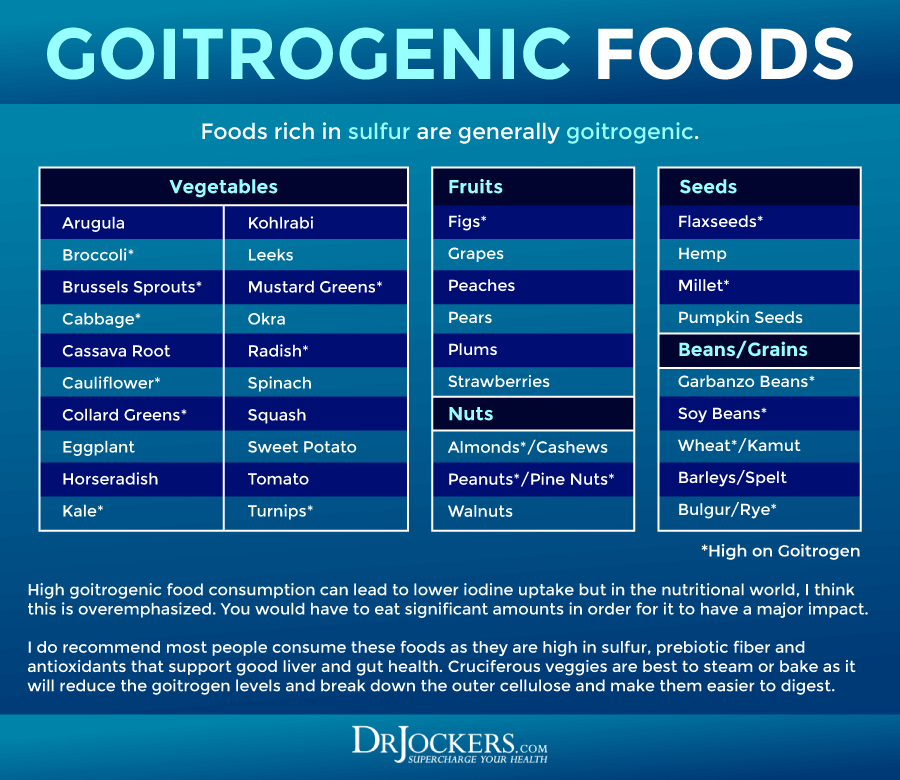
How Much Iodine Should You Get?
How much iodine you need depends on your situation. According to the RDA recommendations, for infants under 6 months, the recommended intake is 110 mcg. For infants between 7 and 12 months, it’s 130 mcg. Between age 1 and 8 years old, the recommendation is 90 mcg of iodine.
Between ages 9 and 13, the recommendation is 120 mcg. For children between teenagers between 14 and 18 and adults over 18, 150 mcg of iodine is the daily recommended intake except for women who are pregnant or breastfeeding. During pregnancy, women should get around 220 mcg of iodine and while breastfeeding, they should aim for 290 mcg (24).
While the RDA is unable to establish the tolerable upper-intake of iodine for babies under 12 months, they have recommendations for other ages. For ages 1 to 3 the tolerable upper intake of iodine is 200 mcg, for ages between 4 and 8, it’s 300 mcg, for ages between 9 and 13, it’s 600 mcg, for ages between 14 and 18 (including during pregnancy or breastfeeding), it’s 900 mcg, and for 19 and over (including during pregnancy and breastfeeding), it’s 1100 mcg (24).
*The RDA levels may be enough to avoid developing goiters but they are not enough to get you all the benefits of iodine sufficiency. Most functional health practitioners recommend at least twice the RDA amount and up to 2 -3 mg daily of iodine to reach sufficient levels

Testing
While iodine deficiency is increasingly common and can lead to serious health issues, I don’t recommend taking high doses of iodine without testing. Taking too much iodine can become a problem as well. I recommend that you get your iodine levels tested first then if needed, start with supplementation with the help of a functional medicine practitioner. Starting with a lower dose at first is usually the best, however, it depends on your personal health and needs. My team and I are always here to guide you.
Here are four ways you can get your iodine levels tested:
One Sample Urine Test
This is the most common method that conventional doctors use at their office. While this iodine test can offer some insights, it is not as accurate as the loading test, which I will describe next.
Blood Test
Blood testing is a very accurate way to measure your iodine levels. There is one catch. Most labs don’t offer such blood tests so it’s highly unavailable.
Iodine Patch Test
The iodine patch test is a simple general test that can check for iodine deficiency. This test involves a 2 x 2 or 3 x 3 patch on your forearm, inner thigh, or abdomen with a 2 percent iodine tincture. These are available at most pharmacies and drug stores, as well as online here.
While most iodine solutions have an orange tint, some are clear. Be sure to buy an orange solution so that it shows up on your skin. You may need to ask for it at the counter since iodine is sometimes kept behind the counter or in a glass case.
If you are deficient in iodine, the patch will fade or completely disappear within a short time, usually within 12 hours or less. 18 hours
While this is not the most accurate iodine test and doesn’t test for exact iodine levels, it is very simple and can serve as a great guide. Starting off with this test is a good idea and if you are suspicious of an iodine deficiency, you can move onto the iodine loading test next.

Iodine Loading Test
The iodine loading test is not the most convenient test, however, it’s pretty accurate and very useful. It measures the excretion of iodine over a 24-hour period by collecting all your urine samples within a 24-hour period. You need to pick the right day for this when you will be able to collect samples every time you visit the bathroom.
For this test, you first do a pre-test, where you urinate in a test kit in the morning after going 5 days without taking any iodine supplements or eating any sea vegetables that are very high in iodine. Next, you will need to take a 50 mg of iodine (76 drops of the detoxadine) and you will collect all your urine over the next 24 hours before sending the urine off to the lab.
The 50 mg of iodine is a very high dose, however, taking it once for this test shouldn’t cause any health issues. If you are concerned about any negative effects, talk to your practitioner to see if it’s the right iodine test for you. If you have hyperthyroidism or Graves’ disease, this test is contraindicated and should not be performed.
If you have sufficient levels of iodine, you will release 90 percent or more of the iodine within the 24-hour testing period. Those with iodine deficiency will release lower levels. The less iodine you excrete within the 24-hour period, the higher the chance that you are deficient in iodine. You can check out the Iodine Loading test here.

Best Food Sources of Iodine
The best food sources of iodine include:
- Seaweed, including nori, wakame, and kombu kelp
- Baked cod
- Shrimp
- Tuna
- Eggs
- Cranberries
- Dried prunes
- Navy beans
- Lima beans
- Baked potatoes

Iodine Rich Recipes
To increase your intake of iodine, I recommend adding foods that are naturally high in iodine to your recipes. Sprinkling seaweed on your salads and meals is a great idea. I also recommend the following recipes:
- Colorful Chicken Vegetable Salad (if you add some seaweed for iodine!)
Iodine Supplementation
If you are dealing with an iodine deficiency and looking to improve your iodine levels through supplementation, I recommend nascent iodine. Nascent iodine is a monatomic form of iodine that is recommended for use in nebulization by today’s prominent proponents of using iodine for health, Dr. Mark Sircus and Dr. David Brownstein.
My favorite nascent iodine supplement is Detoxadine. It is a certified organic nascent iodine that is created from salt deposits over 7,000 feet below the surface of the earth. This is a pure and concentrated form of iodine supplement. It is the best iodine supplement for thyroid health that I can find on the market. It supports your healthy iodine levels, thyroid health, hormonal health, energy levels, brain health, endocrine health, and detoxification.
Detoxadine contains about 650 mcg per drop (3 drops = 1.95 mg). I recommend that you start with a week where you take 1 drop daily, on the 2nd week take 2 drops daily and on the 3rd week take 3 drops daily. This will give you energy so it is best to take on an empty stomach in the morning or with your first meal.
It’s a convenient and affordable solution with each bottle containing a six-month supply of iodine when used as directed. If you have a particular health condition, it is always advisable to work with your health care practitioner on this.
I would also recommend taking 200-400 mcg of selenium daily if you are concerned with thyroid autoimmunity (Hashimoto’s) and are looking to supplement with iodine. Selenium plays an important in producing selenoproteins that reduce inflammation and thyroid autoimmunity.
Bonus: Nebulizing Iodine or Netty Pot For Respiratory and Sinus Health
I highly recommending nebulizing iodine or using a netty pot with iodine for respiratory and sinus health. A nebulizer is a device that changes liquid medicine into aerosols that you can inhale through a mouthpiece or a mask. They are normally used to deliver various medicines, usually for wheezing, asthma, and other breathing or lung problems.
However, you can use them with natural medicines, like iodine. You can find hand-held nebulizers, air compressors, nebulizers with a mouthpiece, or a face mask, depending on what works for you. I explain how to use a nebulizer in this video.
Nebulizing iodine is a powerful therapy to rapidly clear your lungs from infections. Iodine has a stronger and quicker effect than hydrogen peroxide which makes it perfect for this and you can use these together. You can simply mix 5 drops of Detoxadine in 2 mL of food grade hydrogen peroxide. A 2014 study published in the American Journal of Respiratory Health and Molecular Biology, increased concentration of iodine in the airways can reduce the severity of respiratory viral infections (29).
Additionally, you can also use a neti pot. Neti pots are a popular home-based natural treatment method for nasal congestion and upper respiratory health. It helps to clear out mucus from your nose and improve breathing. A 2021 review published in Explore (NY) has found that nasal irrigation and using a neti pot can help recovery from respiratory health issues (30).
You can buy a neti pot at natural health and health food stores, pharmacies, and online. Add 5 drops of Detoxadine in with water or hydrogen peroxide and run it through your sinuses to help clear your sinus passages.
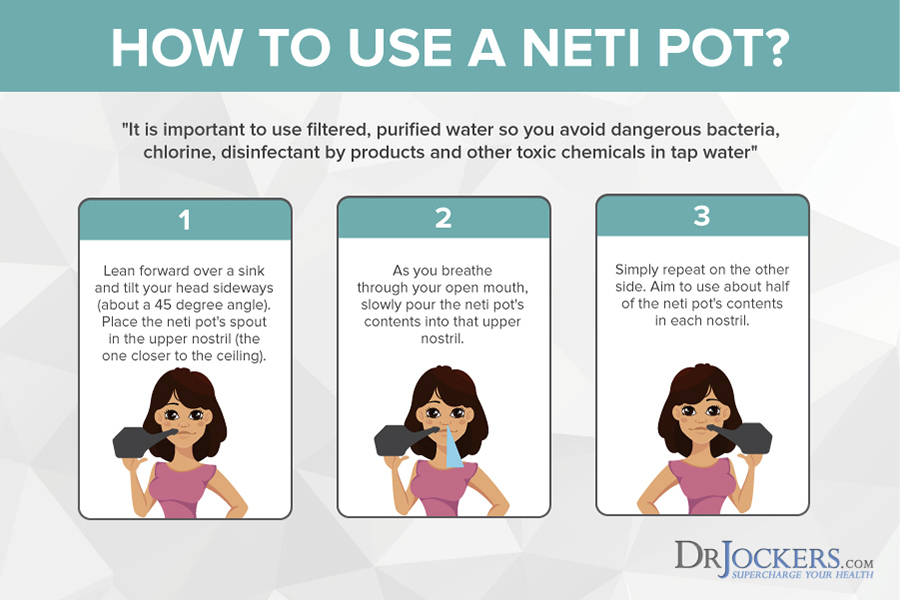
Final Thoughts
Iodine deficiency is a serious global health problem. It is the most easily preventable cause of cognitive development impairment in children. It can also contribute to thyroid imbalance, goiter, and other health issues. I recommend that you check your iodine levels and follow my recommendation by eating iodine-rich foods and supplementing or nebulizing with iodine if you need to improve your iodine levels.
If you want to work with a functional health coach, I recommend this article with tips on how to find a great coach. Our website offers long-distance functional health coaching programs with our world-class team of health coaches. For further support with your health and other goals, just reach out—our fantastic coaches are here to support your journey.
Inflammation Crushing Ebundle
The Inflammation Crushing Ebundle is designed to help you improve your brain, liver, immune system and discover the healing strategies, foods and recipes to burn fat, reduce inflammation and Thrive in Life!
As a doctor of natural medicine, I have spent the past 20 years studying the best healing strategies and worked with hundreds of coaching clients, helping them overcome chronic health conditions and optimize their overall health.
In our Inflammation Crushing Ebundle, I have put together my very best strategies to reduce inflammation and optimize your healing potential. Take a look at what you will get inside these valuable guides below!






Dr Jockers, what’s your take on Lugol’s Solution to suplement iodine? I take 12 drops of 2% solution every morning (with selenium).
Yes that is a great product as well Margaret!
Iodine is what lowered my elevated thyroglobulin antibodies, when nothing else worked. No more brain fog or achiness. It was a miracle and I feel healed from Hashimoto’s symptoms! Dr. Brownstein’s book on Iodine is God-sent!
Great to hear this Carli! Thanks for sharing!
I hope this finds everyone well.
We take Lugol’s iodine 6ml daily. Is it the right amount for us , a 5 yr old, 37 yrs old and a 61 yr old —- all female?
Kindest regards.
Daisy
How do you recommend taking the Detoxadine (e. g. in water, under the tongue, etc.)?